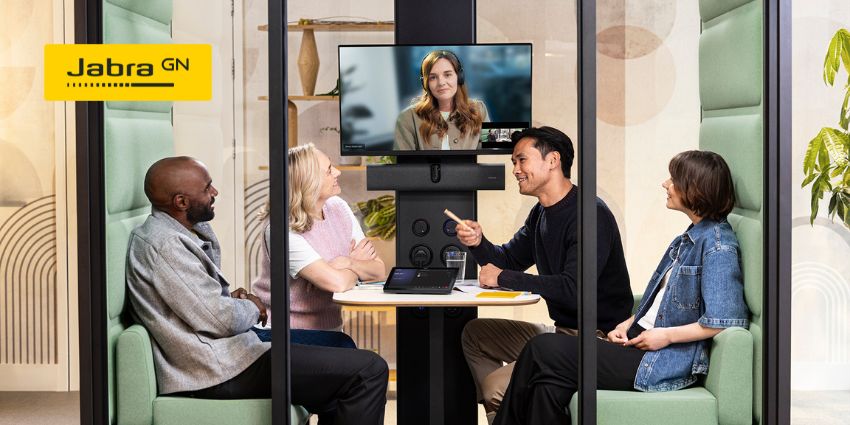The allure of hybrid work has proven irresistible for both companies and employees since its widespread adoption.
Workers enjoy quiet, focused environments without exhausting commutes, while companies dramatically expand their talent pools beyond former geographic constraints.
This success is reflected in recent data: a 2025 CIPD study found that 74% of organizations still maintain hybrid working arrangements.
Yet what began as a dramatic response to a pandemic, where maintaining business continuity was the primary objective, has now evolved.
Companies are beginning to discover a disconnect between in-office staff and hybrid employees who join meetings remotely.
Although companies invested in video conferencing platforms and hardware at the beginning of this transition, these often provide only a basic, static meeting view that does not adapt to different room setups, party sizes, or seating arrangements.
This creates a lack of visibility for some attendees, which results in more than just a disjointed meeting experience.
“If you can’t quite see the people involved in the meeting, that doesn’t lead to an engaging or productive meeting,” James Spencer, Video Solutions Director for EMEA North at Jabra, said.
“When I can see you, I can see your body language and reactions, affirming what I’m saying. Whereas if we don’t have that ability, we’re not sure how something may have been taken in that meeting,” he explained.
Indeed, a study by The London School of Economics (LSE) and Jabra highlighted that participants who were visible during video meetings showed twice the level of engaged facial expressions compared to partially visible colleagues (21% versus 10%).
The cost of this lack of visibility may seem minor when considering just the above statistics, but the evidence shows how all this equals disengagement, meaning meetings pass without the discussion being fully absorbed.
Thus, understanding how this lack of visibility manifests and how it can be solved can help companies maximize meeting time by unlocking human capital.
The Science of Visibility
Although many may have intuitively acknowledged it, the 2025 study by Jabra and LSE quantified it: meeting visibility directly correlates with engagement.
The research analyzed over 500 minutes of recorded video meetings using facial expression analysis to better understand participant behavior based on their visibility to remote colleagues.
It found that visible participants retained focus significantly more—55% of the time—compared to just 34% for those who were harder to see.
It also found that those who weren’t clearly visible maintained neutral facial expressions for 98% of the meeting duration.
All these findings led Dr. Simon Noyce, the study’s lead researcher, to conclude: “Being clearly visible significantly equates with greater attention and engagement, typically doubling these factors compared to participants who are fully or partially occluded.”
This doubling is crucial in understanding just how it can impact meeting dynamics. When people are engaged, meetings become less of a leader’s lecture and more of a group strategy session.
Teams that feel seen are more engaged and therefore more likely to contribute, making meetings more meaningful and productive.
“When we conducted the study, with one group using one set of video technology and another group using the PanaCast 50, some of the feedback we had from the latter group was things like ‘I felt like I was very clearly seen and I was very clearly heard within that meeting,'” Spencer reports.
These dynamics illustrate that visibility is not just about being seen but about being confident that your presence is acknowledged in the discussion.
Yet providing visibility is not just a mindset shift. It requires a technical solution that works in each meeting environment to ensure consistency.
How Advanced AV Bridges the Gap
Meeting room challenges require sophisticated solutions that go beyond standard webcams or basic conference systems.
Hybrid work has made modern offices more fluid than they once were, with hot desking and room booking becoming staples for companies trying to best use their available space.
This nuanced requirement—where participants occupy different seating positions, room layouts vary significantly, and remote colleagues need comprehensive visual context—means that a video setup that works in one room may not work in another.
Thus, addressing visibility demands intelligent video systems capable of adapting to diverse meeting environments.
Jabra’s newly launched PanaCast 40 Video Bar System (VBS) demonstrates how advanced video technology can systematically address visibility challenges in hybrid environments.
The system’s core innovation lies in its 180-degree field of view, achieved through video stitching that captures the complete meeting room environment.
This is vital, as a Jabra study found that 94% of employees rely on small rooms for their day-to-day meetings. Having a full 180-degree field of vision means even attendees in small rooms and close to the camera can be seen with no distortion.
The seamless meeting experience is further augmented by the system utilizing AI-powered features for more natural and engaging meetings. Dynamic composition automatically provides close-up views of participants and highlights the last four speakers, creating an organized layout that helps remote participants follow dynamic conversations naturally.
The transition is so seamless that users remain engaged in conversations occurring in the room throughout the meeting.
“When we had a meeting with the PanaCast 40 VBS, someone who was joining remotely actually said, ‘Oh, I thought there were four cameras in that room and not just the one video bar sitting at the front,'” Spencer noted.
Speaker-tracking technology represents another critical advancement. The PanaCast 40 VBS can automatically adjust the camera framing and focus to follow active speakers without manual intervention. This keeps attention on those speaking and eliminates guesswork or awkward delays from repositioning cameras.
These efficiency gains are compounded when using technology to across a business. This is because, as Spencer notes, that when meetings become more engaging through proper visibility, “they are shorter meetings because you are able to get through the points quicker. You can see if what you’re saying has gone down well and cut down excessive explanation.”
For organizations investing in strong talent, ensuring every voice is heard and seen delivers a clear return on investment in human capital. At the same time, better visibility makes meetings more effective and time‑efficient, allowing companies to save valuable hours across the business.
Building the Future of Hybrid Collaboration
The hybrid work model represents a permanent shift in how organizations operate, making effective meeting technology not just a convenience but a strategic imperative.
Therefore, companies refining their hybrid work strategies must move beyond merely having video capability to ensuring technology actively enhances meeting visibility.
Ultimately, visibility is not just about keeping people attentive; it’s about converting that attentiveness into productivity and performance, where every meeting delivers outcomes rather than simply filling time.
When organizations prioritize visibility as a foundation for engagement, they create environments where hybrid teams can thrive, ensuring that distance never diminishes the power of collective intelligence.







